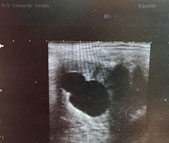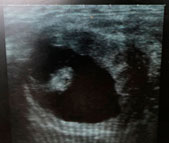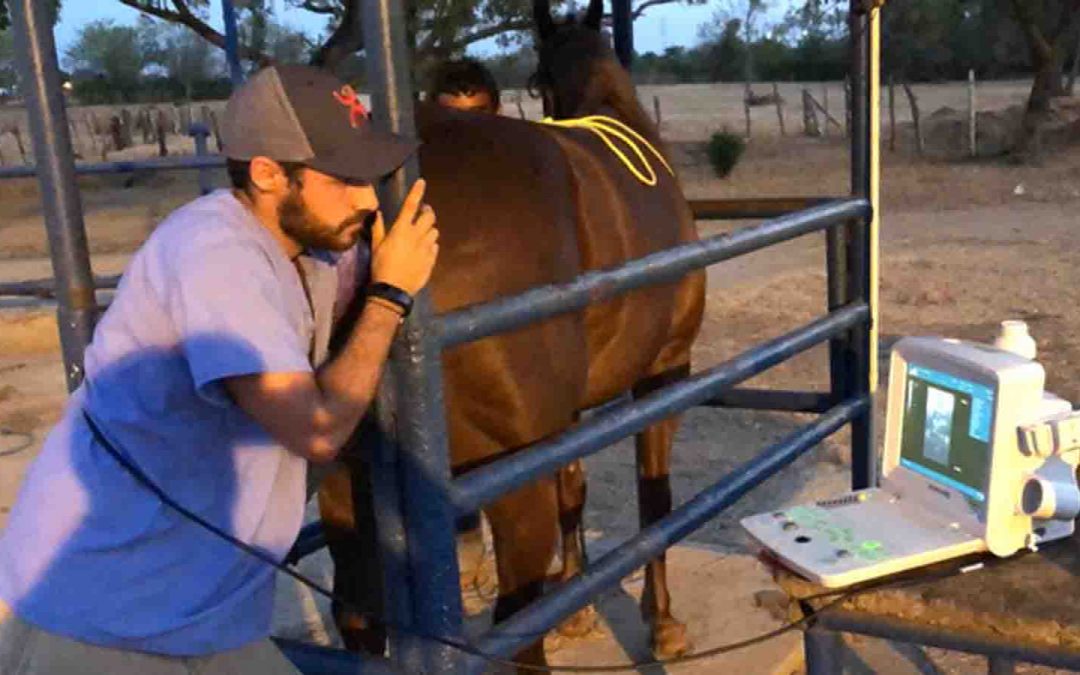When we refer to equine reproduction we find many aspects and topics that we can discuss. A quite interesting topic is equine twin pregnancy, since a pregnancy of this type is not viable or is very high risk for breeding; unlike other mammals that do not present problems in twin pregnancy, such as some ruminants or other animals.
Because it is not viable or dangerous to bring this type of pregnancy to term in mares, we must be prepared when we have to face a case of this nature.
As veterinary doctors we have the responsibility to ensure the well-being of our patients and suggest the best options. It must be taken into account that the owner of the animal has the last word, and I mention this due to the importance we assume when being in charge of the reproduction of a mare.
One of the benefits of monitoring pregnancy work in a mare is to diagnose and prevent a multiple or twin pregnancy and for it to develop and move from the embryonic to the fetal stage. For Izquierdo, A.C (2006) “Equine twin pregnancy is the main cause of non-infectious abortions in mares and is due to the fact that this species is not capable enough of maintaining two fetuses in the same gestation, causing the death of one.” or both products” (1-14).
Rossdale (1991) suggests that due to the type of placenta that mares have, called diffuse epitheliochorial, a 1:1 ratio must be met so that the exchange of nutrients is not altered between the surface of the placenta and the endometrium (p . 288-292).
With the above we can deduce that, when a double pregnancy occurs in a mare, the balance of nutrient exchange will be affected and one or both fetuses will not receive the amount of elements necessary for their development.
Consequently, this will cause the death of one, then the possible malformation or death of the other, generating a high probability of abortion in the mare, in addition to all the alterations and risks that this can generate. For Hafez et al., 2002, abortion is the interruption of pregnancy with the expulsion of a fetus before it is viable (p. 274-281). It should be noted that the substances released from a dead fetus are toxic to its still living counterpart. For Wolfsdorf and Macpherson, (2010), the majority of mares that present a twin pregnancy will suffer a natural abortion around months 7 and 9. (p. 326-331).
When we are in the presence of an equine twin pregnancy, it can be distributed in different ways in the reproductive tract, the embryos can be located one in each horn, called bilateral twin pregnancy (bicornual), or they can both be in the same uterine horn, defined as unilateral twin pregnancy (unicornual). It is important to mention that unilateral pregnancies are more common than bicornual pregnancies and that at the time of a natural reduction by the mare, unicornual pregnancies are more likely to occur.
On the other hand, equine twin pregnancy can also be distributed if it comes from the same ovulation or from two different ones (in the same estrous cycle), in the same ovary or from both, these being:
- Monozygous gametes, which result from the fertilization of an egg by a sperm. For Ramos, Gaviria, 2002, the embryo is implanted and then a differentiation of two primitive lines is generated that results in two identical individuals that have the same genetic heritage and are of the same sex, they develop in the same chorion and sometimes They share amnion and there is competition for fetal membranes, nutrients and oxygen, resulting in the death of one or both embryos.
- Dizygotic gametes are more frequent and come from two eggs in the same estrus, fertilized by two sperm. According to Ramos, Gaviria, 2002, they do not have the same genetic makeup and their similarity is minimal. When two ovulations occur in a single ovary, the twin pregnancy rate is low and when ovulations occur in different ovaries, the twin pregnancy rate increases.
When the death of one of the fetuses occurs in an advanced twin pregnancy, this can generate premature development in the mammary glands, and, in turn, the foals that are born tend to be weak, more susceptible to infections and of a slow development compared to a calf from a single gestation (Wolfsdorf, Macpherson, 2010).
After having analyzed the possible scenarios of twin pregnancies and their problems, ultrasound monitoring is essential to be able to diagnose early and rule out twin pregnancy.
Some of the difficulties that may be present when diagnosing this type of pregnancy are uterine cysts, very early pregnancy detection that may miss a very small embryonic vesicle, incomplete inspection of the uterus or overlooking two vesicles that are adjacent.
When we diagnose an equine twin pregnancy, it is recommended to remove a vesicle, in order to guarantee the optimal development of an embryo, have a normal gestation and prevent any type of risk for the individuals involved.
Mares that manage to carry multiple gestations to term tend to have reproductive problems the following year.
Equine twin pregnancy
When we diagnose twin pregnancy, this is usually from approximately day 11 of gestation (to be more certain of the result). We can give the organism time to regulate itself and generate the reabsorption of a vesicle. It is important to mention that we can wait (in case they arrive) until the day the vesicle is attached to the uterine horn (day 17) to know. the final location of the vesicles and thus decide whether to intervene and perform manual removal of one of them or place the mare on a nutritional diet, generating an episode of stress and the reabsorption of a vesicle.
It is recommended to eliminate the smallest vesicle in size and move it as far as possible from the counterpart to prevent the substances released by this vesicle from being a cause of death for the other. The survival rate for the remaining gallbladder after manual removal exceeds 90% (Wolfsdorf, Macpherson, 2010).
I would like to add that, during the period of vesicle migration, one of them can be removed. As a personal opinion, I recommend manipulating the uterus as little as possible, however, it depends on the discretion of the veterinarian in question.
An alternative to contribute to the mare’s own reabsorption is a nutritional diet for 48-72 hours, to create stress and/or nutrient competition between the vesicles.
Other techniques used for the removal of a fetus in a twin pregnancy are, ultrasound-guided transvaginal reduction, craniocervical dislocation, transcutaneous ultrasound-guided reduction and/or removal of both (induced abortion).
One of the management alternatives to reduce the risk of twin conception is not to serve mares with two dominant follicles of possible ovulation, or to wait for the second follicle to ovulate. However, in mares with low fertility problems, the presence of two dominant follicles may be beneficial, since we would have a double option of becoming pregnant, and then an embryo would be eliminated, in case a double pregnancy results.
The mare has the ability to spontaneously reduce twin pregnancy on its own in approximately 75% of cases of unilaterally placed twins, and in 15% of cases of bilaterally placed twins (González del Pino, 2010).
On the other hand, for Ginther, 1989, “83 to 89% of unilateral double pregnancies are naturally reduced to a singular, and only 4% of bilateral pregnancies are reduced by themselves to singles.” In this sense, the final decision to exercise any of these embryonic or fetal elimination practices rests with the owner of the mare, since it can cause an impact on some cultures and/or societies.

14 days of gestation

20 days

29 days
Unilateral twin pregnancy and resorption of a gallbladder through diet.
Veterinarian Eduardo Prado Carroz
University of Zulia, Faculty of Veterinary Sciences (FCV)
Member of the College of Veterinary Doctors of the state of Zulia, no. 2483
For anyone who may be interested, you can contact us through social networks, on Instagram as @espacio_equino
Bibliographic references
- Izquierdo, A. C. (2006). Factors related to abortion in mares. Electronic Journal of Veterinary Medicine, 7(1), 1-14.
- Hafez E.S.E. and Hafez B. 2002. Reproduction and artificial insemination in animals. McGraw-Hill Interamericana. 7th edition. Mexico. 43, 274-281.
- RAMOS, J.I. and GAVIRIA, M.T. Reproductive physiology guide, for course I reproduction. De La Salle University. Bogota. 2002
- González, F. (2010). Electronic journal of Veterinary Medicine 1695-7504, 2010 Volume 11 Number 12.
- Rossdale, P. 1991. Breeding and Reproduction of the horse. Editorial Acribia, S.A. Chapter 10 Stress, death and abortion of the fetus. Pages 288-292
- Wolfsdorf, K. E., & Macpherson, M. L. (2010). Management of twins. Clin Theriogenol, 2, 326-331.
- Roberts, C. Termination of twin gestation by blastocyst crush in the broodmare. J Reprod Fertil Suppl 1982;32:447-449.
- Knottenbelt, D.C.; Pascoe, R.R.; Lopate, C.; LeBlanc, M. 2003. Equine Stud Farm Medicine and Surgery. Ed. Saunders, Chapter 7. Pregnancy. Pag. 242-246
- Troedsson, M.H. 1997. Robinson 4 Current Therapy in Equine Medicine. Ed. W.B. Saunders Company. Section 12, Reproduction: Abortion. Pág. 534-541.
- Ginther, O.J. The nature of embryo reduction in mares with twin conceptuses: Deprivation hypothesis. Am J Vet Res 1989;50:45-53.


Recent Comments